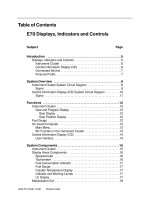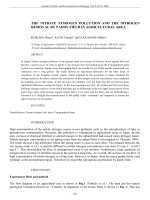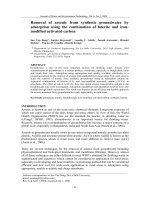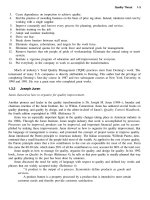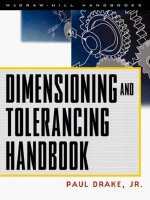The Control Techniques Drives and Controls Handbook
Bạn đang xem bản rút gọn của tài liệu. Xem và tải ngay bản đầy đủ của tài liệu tại đây (2.58 MB, 7 trang )
Contents
Preface xiii--xix
1 Industrial motors 1
1 D.C. motors 1
General 1
Fundamental equations and performance 2
Wound-field motors 2
Permanent-magnet motors 3
Operating principles 4
Commutation 4
Rotation 5
Compensation 5
D.C. PM commutation 6
Construction of the D.C. motor 6
D.C. motor frame 6
D.C. motor armature 6
Brush gear 7
Mountings 7
D.C. PM design 7
Rotor inertia 8
Permanent-magnet materials 8
2 A.C. induction motors 8
General 8
Fundamental equations and performance 9
Electrical characteristics of induction motors 9
Torque characteristics 10
Voltage-frequency relationship 11
Increased voltage 12
Reduced frequency 12
Slip-ring induction motor 13
Speed-changing motors 13
A.C. induction motor construction 14
3 A.C. synchronous motors 15
General 15
A.C. synchronous motor construction 17
4 Brushless servomotors 17
General 17
Principles of operation of brushless servomotors 18
Introduction 18
Torque constant 18
Relationships between torque and back e.m.f.
constant 19
Stationary torque characteristics 19
Construction of brushless servomotors 20
Stator structure 20
Rotor structure 20
5 Reluctance motors 21
6 A.C. commutator motors 22
7 Mechanical and environmental 22
Mounting of the motor 22
General 22
IEC 60034-7 standard enclosures 22
NEMA standard enclosures 22
Degree of protection 24
General 24
IEC 60034-5 24
US practice 25
Cooling 26
General 26
Air filters 27
Duty cycles 27
Continuous duty -- S1 28
Short-time duty -- S2 28
Intermittent duty -- S3 28
Intermittent duty with starting -- S4 29
Intermittent duty with starting and electric
braking -- S5 29
Continuous operation periodic duty -- S6 29
Continuous operation periodic duty with
electric braking -- S7 29
Continuous operation periodic duty with
related load speed changes -- S8 30
Duty with nonperiodic load and speed
variations -- S9 30
Duty with discrete constant loads -- S10 30
Terminal markings and direction of rotation 30
General 30
IEC 60034-8 30
NEMA 32
Ambient conditions 33
Introduction 33
W. Drury (Ed.)
The Control Techniques Drives and Controls Handbook
Temperature 33
Altitude 34
Power supply system 34
Noise and vibration 34
General 34
Vibration 34
Noise 35
Motors for special applications 37
Geared motors 37
Brake motors 37
Torque motors 37
Motors for hazardous locations 37
General 37
CENELEC 37
North American standards 39
Testing authorities 39
8 Effects of semiconductor power converters 40
General 40
Drive converter effects upon D.C. machines 40
Drive converter effects upon A.C. machines 40
Introduction 40
Machine rating -- thermal effects 40
Machine insulation 40
Bearing currents 46
Overspeed 48
Motors for hazardous locations 48
2 Power electronics 51
1 Power semiconductor devices 51
General 51
Diode rectifier 51
Thyristor 52
Thyristor gating requirements 54
Power losses and current ratings 54
Surge current ratings 55
High-frequency current operation 56
Gate turn-off thyristor 56
Switching characteristics and gate drive 57
Snubber design 57
Voltage and current ratings 57
Bipolar Transistor 57
Voltage ratings 58
Current ratings 58
Switching characteristic and base drive 59
Safe operating areas 60
Short-circuit performance 61
MOSFET 61
Voltage and current ratings 62
Switching performance 62
Safe operating area 62
Parasitic diode 62
Insulated-gate bipolar transistor 63
Operation 63
Voltage and current ratings 63
Switching behaviour and gate drive 63
Safe operating area 64
Short-circuit performance 64
Series and parallel operation 64
Integrated-gate commutated thyristor 65
Voltage and current ratings 65
Switching behaviour and gate drive 65
Other power devices and materials 66
MOS-controlled thyristor 66
MOS turn-off thyristor 66
Silicon carbide 67
Power device packaging 67
Pressure contact packages 67
Large wire-bonded packages for power modules 67
Small wire-bonded packages for discrete devices 69
Applications 70
2 Drive converter circuits 72
A.C. to D.C. power conversion 72
General 72
Converters for connection to a single-phase
supply 73
Converters for connection to a three-phase
supply 74
Voltage ripple characteristics 76
Practical effects 76
D.C. motor drive systems 76
D.C. to D.C. power conversion 79
General 79
Step-down D.C.-D.C. converters 79
Step-up D.C.-D.C. converters 81
A.C. to A.C. power converters with intermediate
D.C. link 81
General 81
Voltage source inverters 81
Current source inverters 83
Direct A.C. to A.C. power converters 85
General 85
Soft starter/voltage regulator 85
Cycloconverter 86
Static Scherbius drive 86
Matrix converter 87
3 Speed and position feedback devices 89
1 D.C. tachometer generator 90
General 90
Output voltage ripple 90
Temperature effects 91
Linearity and load effects 91
Stability of the output 91
Maximum terminal voltage 91
Maximum operating speed 91
Mechanical construction 92
2 A.C. tachometer generator 92
3 Resolver 92
Design principles 93
Synchros 93
Torque synchros 93
Control synchro 94
Resolver 94
General 94
Computing resolvers 94
Phase shifting 95
Brushless resolvers 95
Multipole resolvers 95
A.C. rotary pickoffs 95
Resolver-to-digital conversion 96
4 Encoder 97
Incremental encoder 97
Absolute encoder 98
Sin/cos encoder 99
vi Contentsvi
5 Selection of a feedback device for a
drive system 99
6 Mechanical considerations 100
7 Glossary of terms 101
4 Drive control 103
1 General 103
The ideal control system 103
Open-loop control 103
Closed-loop control 104
Criteria for assessing the performance of a
closed-loop control system 104
2 A.C. motor drive control 105
General-purpose open-loop A.C. drive 106
Space-vector modulator and inverter 106
Reference-frame translation 107
Reference-frame generation 107
Current limit 108
Performance and applications 108
Permanent-magnet servodrive 109
Reference-frame generation 109
Current control 109
Speed control 110
Performance and applications 110
Closed-loop induction motor drive 110
Flux calculator and reference-frame generation 111
Flux control 111
Performance and applications 111
Operation without position feedback 111
Four-quadrant operation 112
Reference-frame generation 112
Performance and applications 112
Direct torque control 113
3 D.C. motor drive control 114
Flux controller 114
Torque controller 115
Performance and applications 116
4 Analysis of and set up of a speed controller 116
Ideal speed controller 116
Calculating the required gains 117
Nonideal effects in a real speed controller 119
5 Switched-reluctance and stepper-motor
drives 121
1 General 121
2 Switched-reluctance motors and controllers 122
Basic principle of the switched-reluctance motor 122
Operation as a motor 123
Operation as a brake or generator 123
To summarise so far 123
Relationship between torque polarity and
motoring/generating 124
Control of the machine in practice 124
Low-speed operation 124
What happens as speed is increased? 124
Medium-speed operation 124
How is performance maintained as speed
increases? 125
High-speed operation 125
Summary of typical/practical control 126
Control of speed and position 126
Polyphase switched-reluctance machines 127
Losses in the switched-reluctance motor 127
Excitation frequency 128
Power electronics for the switched-
reluctance motor 128
Power supply and front-end bridge 128
Power switching stage 128
Single-switch-per-phase circuits 128
Multiple-phase operation 129
Single-switch circuit using bifilar winding 129
Two-switch asymmetrical bridge 130
Advantages of the switched-reluctance system 131
Rotor construction 131
Stator construction 131
Electronics and system-level benefits 131
Disadvantages of the switched-reluctance system 132
Torque ripple 133
Acoustic noise 133
3 Stepper-motor drives 134
Stepping-motor principles 134
The permanent-magnet motor 135
The VR motor 135
The hybrid motor 135
Stepping-motor drive circuits (logic modes) 136
Unipolar switching 137
Bipolar switching 137
High-speed stepping -- L/R drives 139
Chopper drives 139
Bilevel drives 139
Application notes 139
Effect of inertia 139
Resonance 139
Special products 140
Stepper/encoders 140
Space-rated steppers 140
Fuel-control actuators 140
6 Practical drives 141
1 General 141
Digital input 143
Programmability 143
Typical specification 143
Digital output 143
Programmability 143
Typical specification 143
Analogue input 143
Programmability 143
Typical specification 144
Analogue output 144
Programmability 144
Typical specification 144
2 D.C. drives 145
The technology 145
Drive selection 145
Technical specifications and ratings 148
Drive set up and commissioning 148
Autotune 148
PC-based commissioning tools -- MentorSoft 148
Performance 148
Speed and current-loop response 148
Typical applications 149
Low-power analogue D.C. drives 149
vii
Contents vii
The 4Q2 D.C. drive 149
Cheetah--Puma--Lynx 149
3 A.C. drives 151
Features common to all A.C. drives 151
Power terminal layout 151
Control terminal layout 151
Wiring precautions to prevent electromagnetic
compatibility (EMC) issues 153
Open-loop inverters 153
Specifications and ratings 153
Features and options 153
Methods of control 156
Performance of the Commander SE open-loop
drive 156
Typical applications 157
The universal A.C. drive 157
The concept of a universal drive 157
Unidrive option modules 158
Open-loop operation 159
Closed-loop operation 159
Servo operation 160
Regeneration mode 162
High-performance servodrives 163
Performance 166
Summary of practical advantages of SLM
technology 168
Applications 169
4 Soft-start A.C. motor control 169
Conventional starting 169
Direct-on-line starting (DOL) 169
Star-delta starting 169
Auto-transformer starting 170
Disadvantages of conventional starting 170
Electronic soft start 171
Typical applications 171
5 Application boards and software 172
Applications module 172
Software commissioning tools 173
Communications modes 173
Drive set-up wizard 173
Commissioning screen 174
Monitoring screen 174
Parameter list 174
7 Position and motion-control systems 175
1 General 175
2 Basics of motion control 177
3 Typical motion functions 180
Position lock -- electronic gearbox 180
Direct positional lock 180
Ramped nonrigid lock 180
Ramped rigid lock 180
Simple single-axis positioning 182
CAM functions 182
Multiaxis positioning 183
4 Programmability 187
5 Summary 188
8 Communications systems 189
1 Introduction 189
Drive set up 190
Drive control 191
Summary 191
2 Network basics 191
Physical layer 192
Network cables and connectors 192
Interface circuits 192
Data encoding 192
Network topology 193
Data-link layer 194
Framing 194
Data model 194
Media access control 194
Error handling 195
Conclusions 195
Application layer 195
Device profile 195
3 Simple fieldbus systems 196
Modbus 196
Control Techniques' protocol 196
4 Fieldbus systems 197
Requirements for drive applications 197
Physical layer 197
Error detection 197
Dynamic performance 197
General message services 197
Centralised versus distributed intelligence 197
Profibus DP 197
Interbus-S 198
CAN 198
DeviceNet 198
CANopen 198
CTNet 198
9 Supply harmonics due to drives 199
1 Overview 199
2 Regulations 200
Regulations for installations 200
Regulations and standards for equipment 200
3 Harmonic generation within variable-speed drives 201
A.C. drives 201
D.C. drives 203
Effect of loading 203
4 The effects of harmonics 203
5 Calculation of harmonics 204
Individual drives -- D.C. 204
Individual drives -- A.C. 205
Systems 205
Isolated generators 206
6 Remedial techniques 206
Connect the equipment to a point with a high
fault level (low impedance) 207
Use three-phase drives where possible 207
Use additional inductance 207
Additional A.C. supply-line inductance 207
Additional D.C. inductance 207
Use a higher pulse number (12 pulse or higher) 207
Use a drive with an active input stage 211
Use a harmonic filter 211
10 Electromagnetic compatibility (EMC) 213
1 Introduction 213
General 213
Principles of EMC 214
viii Contentsviii
EMC regulations 214
2 Regulations and standards 214
Regulations 214
Standards 215
3 EMC behaviour of variable-speed drives 215
Immunity 215
Low-frequency emission 216
High-frequency emission 216
4 Installation rules 217
EMC risk assessment 217
Basic rules 217
Segregation 217
Control of return paths, minimising
loop areas 217
Earthing 218
Simple precautions and fixes 219
Full precautions 219
5 Theoretical background 220
Emission modes 220
Principles of input filters 221
Screened motor cables 222
Ferrite ring suppressors 222
Filter earth leakage current 222
Filter magnetic saturation 222
6 Additional guidance on cable screening for
sensitive circuits 223
Cable screening action 223
Cable screen connections 223
Recommended cable arrangements 225
11 Systems design 227
1 General 228
2 Design matrix 228
3 Dynamic/resistive braking 228
General 228
D.C. motor braking 228
Example calculation of a brake resistor of a
D.C. motor 231
A.C. regeneration and braking 231
Example calculation of a brake resistor
of a PWM A.C. induction motor drive system 232
4 Fusing 233
General 233
Protection of mains-drive and drive-motor cabling 233
Protection of drive components 233
5 Motor overtemperature protection 234
General 234
Overtemperature protection of a converter-fed
motor 235
What can be used 235
What cannot be used 235
6 A.C. drive motor cabling 236
General 236
Closed loop -- induction motor 236
Cable resistance 236
Cable-charging currents 236
Closed loop -- PM servomotor 237
Cable resistance 237
Cable-charging currents 237
Open-loop current control--induction motor 237
Cable resistance 237
Cable-charging currents 237
Limits to cable length 237
Example 240
Output chokes for long motor cable applications 240
General 240
Principles 240
Calculations 240
Example 241
Position of chokes in multiple motor
configurations 241
Typical recommended cable size 242
7 Power supply considerations 243
High or low line voltage 243
Supply frequency variations 243
Supply impedance/fault level 243
Low supply impedance 243
High supply impedance 243
Multiple drive installations 244
8 Thermal design of enclosures 244
General 244
Calculating the size of a sealed enclosure 244
Example 244
Calculating the air flow in a ventilated enclosure 245
Example 245
9 Installation and maintenance of standard motors
and electronic equipment 246
Motors 246
General 246
Storage 246
Installation 246
Maintenance guide 247
Brush gear maintenance 247
Electronic equipment 248
General 248
Siting of equipment 248
Ventilator systems and filters 249
Condensation and humidity 249
Fuses 249
10 Common D.C. bus configuration of A.C. drives 250
General 250
A simple bulk uncontrolled rectifier 250
Using the mains supply converter in one drive to
supply all drives from its D.C. link 252
Effectively hard paralleling of all drive input
rectifiers 252
A bulk four-quadrant controlled rectifier feeding
the D.C. bus 252
A bulk four-quadrant PWM converter feeding
the D.C. bus 253
Note on EMC filters for common D.C.
bus systems 254
11 Mechanical vibration, critical speed and
torsional dynamics 255
General 255
Example 255
Causes of shaft vibrations independent of
variable-speed drives 255
Subsynchronous vibrations 256
Synchronous vibrations 256
Super-synchronous vibrations 256
Critical speeds 256
Applications where torque ripple excites a
resonance in the mechanical system 256
High-performance closed-loop applications 257
ix
Contents ix
